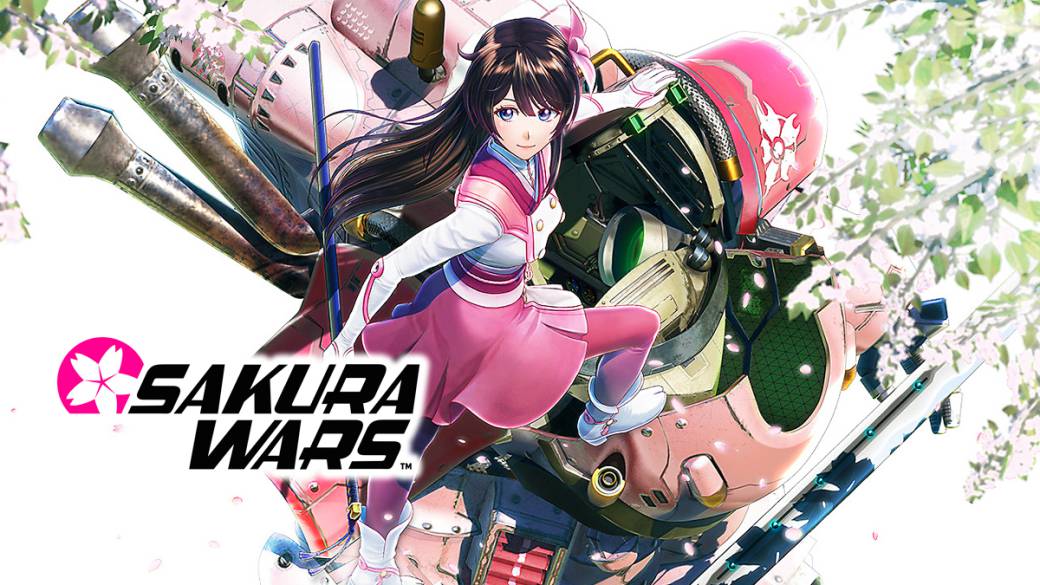
We analyze the new installment of the Sakura Wars series, which marks the return of the popular Japanese series with a new cast of characters and combat system.
Ten years, that's the span of time that has passed since the first, and at the same time last, time the Sakura Wars series saw the light of day in the West. Back then, in 2010, the conversion for Wii of Sakura Wars: So Long My Love was exclusively released for this platform in European territory, unlike the United States that would have the adaptation for PlayStation 2 on two discs, offering what it promised to be the new image of the series and an attempt to expand the borders of the franchise to international territory, which was weighed down by the low acceptance of the game.
After a period in which the franchise was left in creative limbo, hopes were restored when the return of the series was announced with a new title that promised to be the start of a new cycle. Today the wait is over and finally comes this new installment marked by a renewed design for both its roster of characters and the combat system, but retaining much of the identity of the franchise.

The series picks up Tokyo as the setting for the game's storyline, something that hasn't happened since the series' penultimate installment, Sakura Wars 4. The return is both a continuation of the story as well as a smooth reboot of the series. , framed in a time span of 12 years after the events of Sakura Wars: So Long, My Love. The combat units of Tokyo, Paris and New York have disappeared after an intense battle that took place in the Japanese capital, leaving only Sumire Kanzaki as the sole survivor of it.
A decade later, in 1940, year 29 of the Taishô era in the game, Seijuro Kamiyama is transferred to Tokyo as the new captain of the renewed Tokyo Combat Unit, commanded by Sumire Kanzaki, which secretly operates in the Grand Theater Imperial in the same way as in the past with its former members. However, the situation is not very encouraging since theatrical performances are a disaster, the budget is scarce and the Japanese government considers the dissolution of the unit. Against this background, Sumire urges the Kamiyama to lead the Floral Combat Division to participate in the Combat Units World Cup to maintain and preserve its legacy. However, the situation will be complicated on the one hand by tensions with the Shanghai Combat Unit, who protect the city in the absence of an adequate force to protect it, and on the other hand the appearance of a mysterious masked woman allied with the forces. demonic, whose appearance is suspiciously reminiscent of Sakura Shinguji.
Although the protagonism is carried out mainly by Kamiyama being the controllable character, each of the girls that make up the new formation of the Floral Combat Division will also have importance, being especially important Sakura Amamiya who, apart from being Seijuro's childhood friend, has as an aspiration to follow in the footsteps as an actress and fighter of Sakura Shinguji, essential member of the previous unit. As support, and a great friend, she has Hatsuho Shinonome, a skillful priestess with the hammer in combat and also with the power to clean the impurities produced by demons, whose main task is to take care of keeping the sacred crystal found in the courtyard of the Great Imperial Theater. Next is Clarissa "Claris" Snowflake, who is passionate about books to the point of focusing her permanent attention on them without anyone being able to bother her until they are finished. Throughout the game you will discover the problems that your special power causes you to the point of considering that it is a threat to your companions if you use it. On the other hand, there is Azami Mochizuki, a young girl capable of using ninja techniques and whose work is essentially based on completing different types of secret missions. Finally there is Anastasia Palma, a renowned actress who joins the unit as the main attraction for the theater while teaching the rest of the girls the essential notions for improvement in performances, also counting as a member in combat.
Throughout the game, exploration parts will alternate, in which a series of main objectives to be fulfilled will be presented to advance the plot along with other secondary objectives that will present events that will involve the main and secondary characters. In principle, you will only have access to the interior of the Great Imperial Theater and its different locations, which include the ground floor where the stage and the stage are located, as well as other rooms such as the changing rooms or the exterior patio, the first floor where they are located. the rooms of each of the girls in the floral combat unit, and the underground facilities that include the bathroom, the repair room and the command control. Through the chapters, access to other areas of Ginza will be opened with some points of interest where various events will also take place, although these will be much smaller.
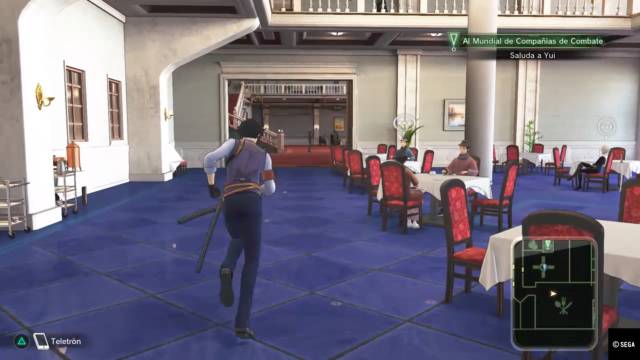
As a support tool during the game will be the Teletron, a device that Kamiyama receives at the beginning of the plot and that includes different consultation options as well as receiving messages from other characters, both priority concerning the plot and additional ones that will send the girls of the unit, including warnings to carry out assault missions, which involve fighting in battles against small hordes of enemies in the streets of Ginza. The first of these is the map that allows you to see the different locations of the Great Imperial Theater and the areas of Ginza, once unlocked, while marking the locations of the main events and those related to the characters. Then you can check the list of events of both the main plot, in the Kamiyama file, as well as the females of the unit and of other kinds, with the possibility of being able to see the animated sequences that some of them will have.
Another option available is the list of stickers (bromide), which are collectible photographs of the characters in the game that can be obtained by going to the store of Komachi, located at the entrance of the theater, in certain locations of the game, certain for a flashing glow, or as a reward for completing certain character events. You can also get some specials dedicated to the members of the units of each of the previous games.
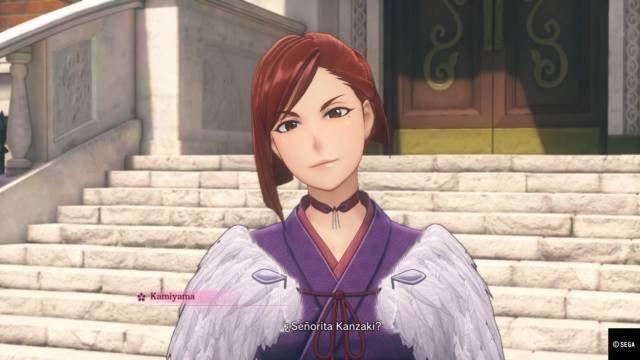
Finally there is access to the Koi-Koi Wars minigame, which will be unlocked when advancing in the first chapters of the game. In this mode, you can face the characters of the game, both from different units and others of a secondary nature, in Hanafuda card games. The objective of the game is to win hands to reduce the amount of mon that the opponent has, having to play cards, which have different designs, which can be paired in order to get one or more types of set, such as getting to collect all of which have a ribbon or gather the basic card, each having a certain value in mon. The game is developed by playing cards in such a way that they can be matched with those on the table, while a card is drawn from the deck, which, if it also has a partner, will become part, along with the previous ones, of the player's list. player on that turn. When completing a list, a warning will appear on the screen along with the corresponding amount in mon to be deducted from the opponent, having at this point the option to end the round or use the Koi-Koi command and continue in order to obtain more sets, what that will give more points if possible, although it is a double-edged sword since the opponent can change the tables. Thus the game will happen in several rounds in which the objective will be to leave the opponent without mon. The first time you play, you can only face Sakura, but throughout the game and completing the game, additional characters will be added to the campus and you can even play this minigame from the main menu.
LIPS, short for Live & Adventure Picture System, will come into play in both major and minor events, which in this installment maintains the same classic foreplay scheme in which at certain moments of conversations Kamiyama can choose between different answers available in a limited time, also including the option of exceeding said limit as an additional option. This will cause various reactions in the characters in such a way that their affinity level will increase or decrease. In other cases the system will be presented differently, having to measure the intensity of the actions using the left stick for it.

At certain moments of the game each of the girls will have a face-to-face moment with Kamiyama, this consisting of a special event in the room of each one of them where, based on interactions moving the cursor both across the girl and the elements of the place, advance the conversation to the point of gradually increasing the level of affinity that will lead to a more romantic environment, which will allow the interaction to continue to praise the physical attributes of the female in question (such as the eyes or the hair), although you will have to be careful since it can cause your discomfort, something that will be evident through your reactions and the phrases that you will say to reach that point.
The game will be developed through a chapter format similar to an animated series, with a preview of the events of the next episode at the end of each one, in which the action will be based on the exploration part, detailed in previous lines, and another dedicated to combat. The latter will take the group to different confrontations well in phases that take place in dimensional cracks inhabited by demons, each with a final boss, and others in which you will have to participate in the rounds of the Combat Units World Cup. Despite the fact that in both the combat mechanics are the same, their development is not.
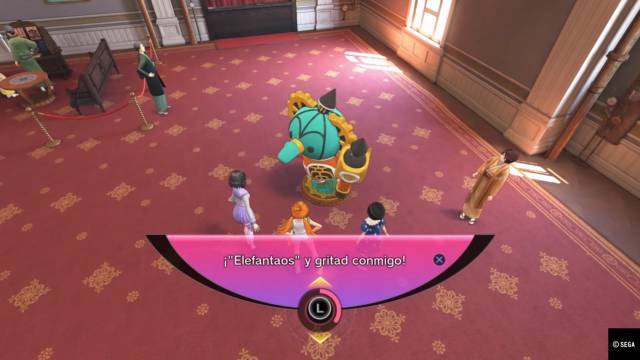
In the dimensional cracks, which have different designs, the objective will be to advance through each area facing hordes of enemies that will slow down the advancement of the characters, having to finish them all in order to resume progress. During each phase, various types of enemies will appear, including some special ones that will have greater defensive and attack power. These phases will also have areas where the use of the turbo will be essential to cross walls that will allow crossing empty spaces or climbing to access high areas, as well as others where it will be necessary to jump between platforms to advance. At the end of each of them, you will have to face a final boss, who will present a battle as he is more powerful and use techniques that will make the confrontation somewhat difficult.
On the other hand, the matches of the World Combat Units are played differently, consisting of three rounds in which the objective is to achieve the highest score in two of them in order to win the confrontation. For this, it will be necessary to defeat the enemies that will appear in the different areas of the field, made up of various areas of platforms connected to each other. To make things easier, a dim column of light will appear that will mark the area where to find the enemies that require priority by granting more points, which stand out for being bright gold. In the middle of the rounds, it will not be possible to attack the rival combat units, but it will be possible to face them later in a 3 against 3 confrontation. Before facing these phases, it will be necessary to choose two members of the Floral Division as companions in combat, which, when selected, will increase their level of affinity.

At the end of each combat phase, the game will offer a qualification screen that will measure the time used, the enemies defeated and other relevant data to measure the team's performance, in turn providing a range, which will cover from D to S the latter being the maximum possible. This in turn will affect the character's affinity, especially by achieving the highest rating.
It should be noted that the game lacks the option to fix the enemy in combat that facilitates attacking accurately, something that is especially noticeable in aerial enemies that are difficult to hit as they cannot accurately measure attacks and jump level, making the combat a little rough in the long run. The camera does not help in this aspect either, offering some moments when it does not offer an adequate point of view when fighting, although it is not generalized.

The level of affinity will be important not only to determine Kamiyama's love interest at the end of the game, but also the level of motivation that each girl will have in combat, improving her performance when facing the hordes of enemies that will present battle in each level of the game and which in turn will help improve the morale level, which will increase to a total of ten levels that will accumulate when defeating enemies, producing different effects in combat such as attack and defense improvements if you increase or decrease characteristics if it decreases. The affinity can be consulted in the selectable group status option on the intermediate screen of each chapter, with different emotion icons next to each of the females. It will also affect in such a way that, if the level is high enough in combat, both Kamiyama and his companion will be able to execute a combination movement, pressing the touchpad on the controller, which, apart from offering a small animated sequence, will allow you to enjoy a invincibility effect for both for a limited time.
The combat system in this installment leaves behind the tactical cutting system of previous installments to offer an action-based style, being able to control the Koubu units, the combat mechs used by the protagonists, Kamiyama and a companion, which will be determined for each episode, alternating control between them through the L1 button. Attacks are made by pressing the circle buttons, for normal attacks, and triangle, which execute strong attacks, so that combining them you can get chains of attacks that allow you to make additional movements such as being able to launch the enemy into the air and whip them, being able to consult them in the game pause menu. To avoid enemy attacks, you can use the dodge movement, with R1, which when executed at the moment an enemy executes an offensive, will make a perfect dodge that will cause a slowdown time (or bullet time) in which to execute attacks against enemies.
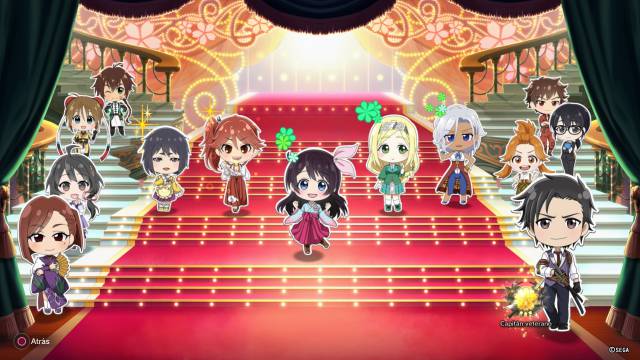
Each unit can execute a special movement which can only be executed by filling a spiritual energy bar, located below the life bar, by collecting blue energy spheres, obtainable by defeating enemies or destroying boxes, which are usually they appear violet in the dimensional cracks. When you have it to the maximum, it will be enough to press the square button to activate the technique, which will have devastating consequences for the enemies and bosses at the end of the phase in addition to offering different effects, such as Kamiyama will launch a series of attacks with his swords at high speed while Azami will launch a large number of kunais that will defeat nearby enemies.
As an additional option, a special virtual training unit called Comba-T Pro can be unlocked by advancing the game in such a way that each of the combats of each completed episode can be played, not only with their respective characters but also with others in order to achieve the best possible rating when finishing them, which will allow, on the one hand, to increase the level of affinity of the characters, although only by achieving the maximum rank in each phase, and also obtaining exclusive cards for the collection.
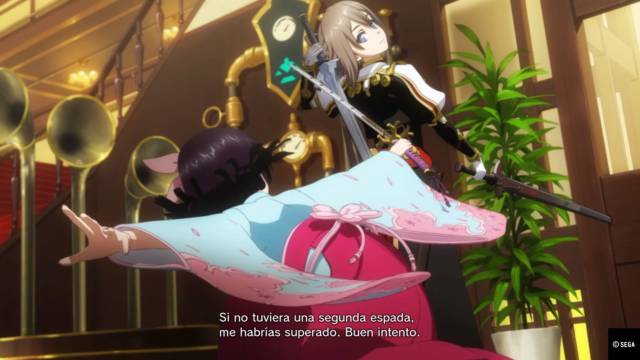
In playable matter, Sakura Wars maintains the basic game scheme of previous installments powered by the use of the 3D graphics engine and leaving behind, to a certain extent, the dependence on 2D illustrations, although they still have a presence for some moments of the game. The use of the LIPS system, in its two aspects, continues to offer possibilities through real-time decisions in such a way that the flow of the game is not interrupted, while the subsequent reactions become interesting to watch. As for combat, the new system in some ways represents a drastic change in a franchise characterized by its tactical combat. At first the sensations that the first bars leave when trying the action approach are to be in front of a system that reminds of the Warriors of Koei Tecmo, especially in the phases of the World of Combat Units, although at a lower level, allowing to face seamlessly to enemies. However, as we delve deeper into the game, we begin to see that the system has some flaws, such as the lack of a targeting system that allows us to face enemies more easily, especially aerial ones that are difficult to hit, And that also leads to problems with camera angles.
In graphics, this installment shows a new visual style. On the one hand, the 2D illustrations for the events that were so prevalent in the previous games give way to fully 3D scenes, offering sequences with the game engine in which not only the different interactions of Kamiyama with the characters stand out, some very funny fits stand out, but also the enormous expressiveness that exudes the rest of the main cast. On the other hand, the locations of the game show enough details, highlighting above all the Great Imperial Theater for its design and different rooms. It is also worth noting the important change in character design in this section, taking Tite Kubo, known for his work in the Bleach manga series, the generational replacement to replace Kosuke Fujishima, a mangaka who has stood out for his designs in series such as Ah ! Megamisama, Taiho Shichauzo or various titles from the Bandai Namco Tales series. The result is a style that, although different, maintains the spirit of the series and manages to more than meet the expectations placed on them. On the other hand, highlight the collaboration of several additional artists for the designs of the members of the remaining combat units and other relevant characters in the game, including Yukiko Horiguchi (illustrator noted for her designs in some of the best-known series from the Kyoto Animation studio ), BUNBUN (known for being the character designer of the different Sword Art Online series), Ken Sugimori (former director of art and character design for the Pokémon franchise), Fumikane Shimada (whose works include her designs for the franchises Strike Witches and Girls und Panzer in anime and Kantai Collection in video games), Noizi Ito (highlighting their designs in the Haruhi Suzumiya series and also in the video game The Guided Fate Paradox by Nippon Ichi Software) and Shigenori Soejima (known for their designs in the different games of the Persona series or in titles like Catherine).

In the sound section, the game has compositions written by Kohei Tanaka, who is mostly known for writing the music for the anime series One Piece, although he has also been a participant in other well-known projects of the Japanese manganime and also video games such as the previous installments of Sakura Wars, Resonance of Fate, Alundra or the two installments of the Gravity Rush series. The melodies of the game include different styles that range from tracks orchestrated with a calm air to others of greater intensity in the moments of action, although among all, the new version of the main theme of the series, Geki! Teikoku Kagekidan
This Reviews has been performed with a digital version provided by the game's distributor.
CONCLUSION
Sakura Wars is presented as the starting point for a new stage in the series, especially due to the new character design and the change in the combat system to an action-focused style, with the counterpoint of maintaining the essence of the previous games, somewhat palpable by the mechanics in the exploration and event parts in addition to the musical compositions, including the main theme of the series. The result is an interesting game that fans of the franchise will like and those who want to start getting to know it, especially this time having texts entirely in Spanish, tasting its history and its characters as well as the different events and content it includes. Unfortunately, the weak point of the game lies in its combat system, which while effective, in the long run denotes the lack of a lock on system and some problems with camera angles.
THE BEST
- The cast of main characters, very charismatic and well developed throughout the game.
- The story, which gains interest with each new chapter.
- Remarkable musical section, both for some orchestrated compositions and for the new version of the main theme of the series.
- Good amount of extra content, highlighting the Koi Koi Wars minigame.
- Texts in Spanish.
WORST
- Lack of self-targeting makes combat somewhat difficult.
- The camera in combat, which at certain times complicates the action.
- The absence of an option to save the game at any time.
Good
It meets the expectations of what is a good game, it has quality and does not have serious flaws, although it lacks elements that could have taken it to higher levels.
